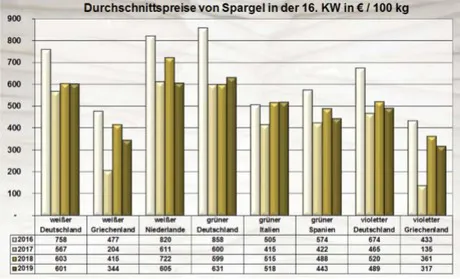Domestic asparagus offers clearly formed the basis of what was to be found in the market. In Munich, many German lots went to the retail trade, so availability in the market square was insufficient to satisfy demand. In Hamburg, however, copious inflows from Hesse and Bavaria appeared. Greece, the Netherlands, Italy and Spain completed events with purple and white asparagus. In the green segment, domestic as well as Italian, Greek, Peruvian and Mexican batches were at hand.
Domestic deliveries expanded but still, locally, these were not enough to meet the demand. On the other hand, enormous shipments came in on several occasions, so that completely selling out was impossible. As a result of all this, prices fluctuated. In general, sales improved during Holy Week as Easter approached. As demand was focused on domestic lots, other European imports did not consistently receive enough attention. Even a very satisfactory quality did not accelerate sales there. This meant that higher prices could not always be sustained.
Apples
Germany continued to dominate the market. Sales did not see any special events, so the prices often remained at the level of Week 15. Sales slowed down from time to time due to the holidays.
Pears
South Africa was number one were, providing Packham's triumph, Williams Christ, Cheeky and more. The inflow increased significantly, enough to meet demand without any difficulty.
Table grapes
The South African and Indian inflow apparently was limited, while shipments from Chile evidently grew. There were numerous varieties available, primarily -and as usual for this season- Thompson Seedless, Crimson Seedless and Red Globe.
Strawberries
Supplies from Germany and the Netherlands increased; At the same time, deliveries from Spain and Greece dropped off slightly. Thanks to the spring weather, sales options improved noticeably.
Lemons
Moderate sales prevailed on this market. With demand-based availability, prices changed only very rarely.
Bananas
On the one hand, sales intensified a lot thanks to the holidays, on the other hand, the warmer spring weather slowed down the marketing quite a bit. Prices predominantly remained at their original levels.
Cauliflower
France dominated events, more so than Italy. Spanish and Belgian inflow was only there in Frankfurt and Cologne. The first shipments from Germany immediately got a good price.
Lettuce
Regarding lettuce, Belgian shipments were most abundant. Local goods became noticeably more important. The prices increased frequently, and sometimes quite strongly, dependent on the volumes available.
Cucumbers
Belgium, the Netherlands and Germany dominated the cucumber trade. There were growing supplies. This had an impact on prices: as demand was unable to keep pace with supply, prices tended to slump a little overall.
Tomatoes
Prices actually only went in one direction: sliding downhill. The reasons for this were extensive availability, too little demand and declining quality.
Bell peppers
The Netherlands dominated the market, more so than Spain and Turkey. Belgium completed the ranges. In general, the price levels usually picked up, while the focus of the business was on the more expensive Dutch products and the cheaper Spanish shipments were somewhat left at the wayside.
